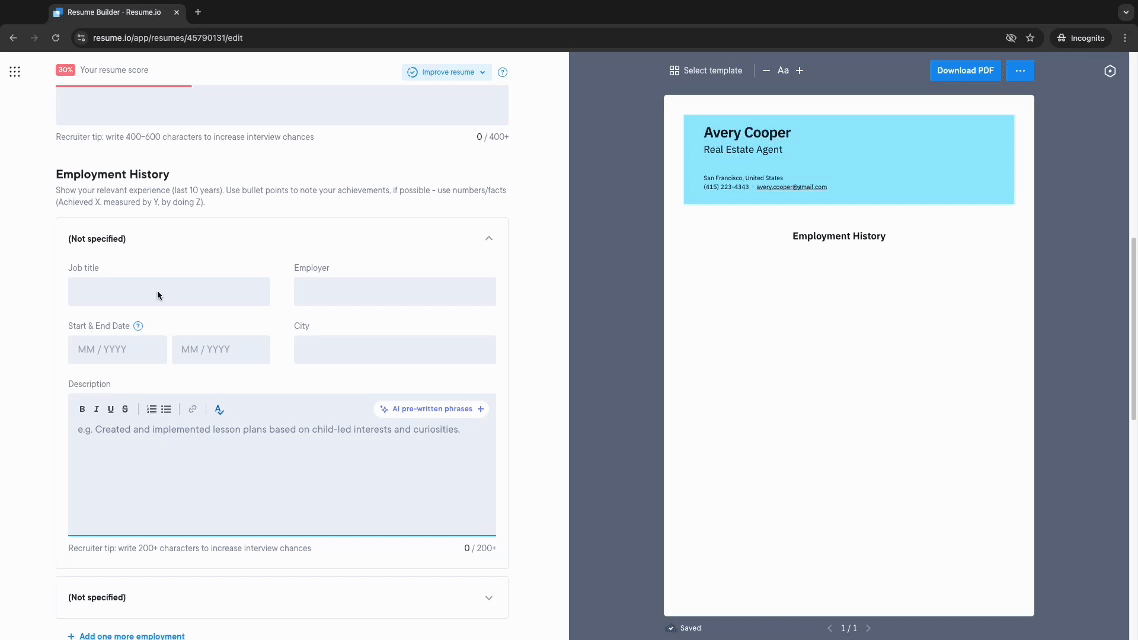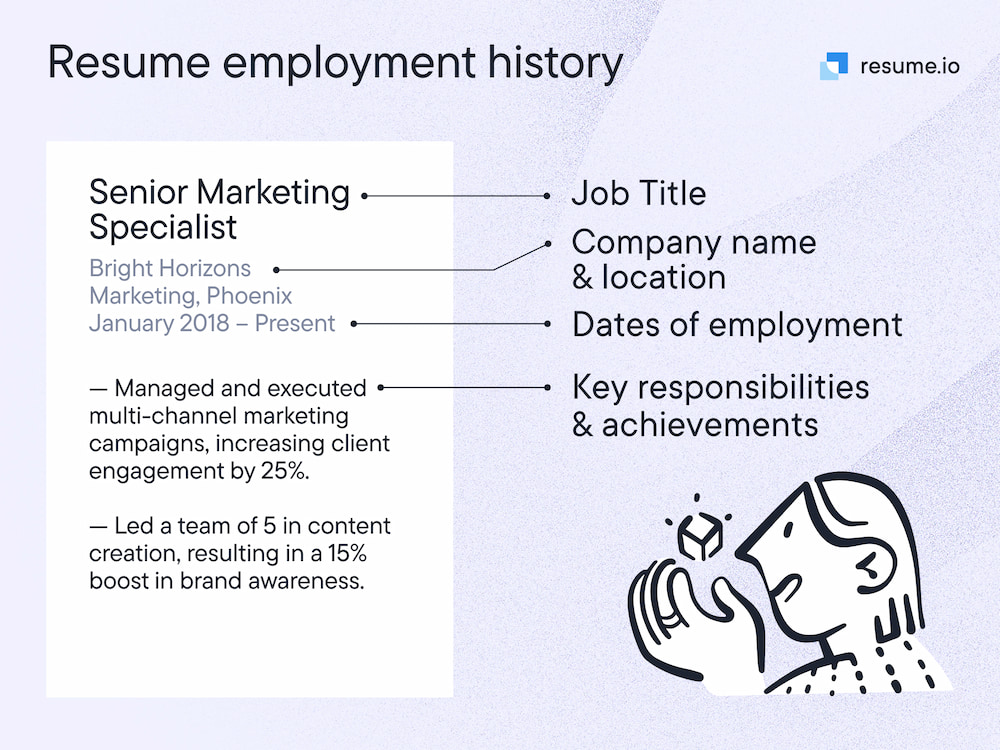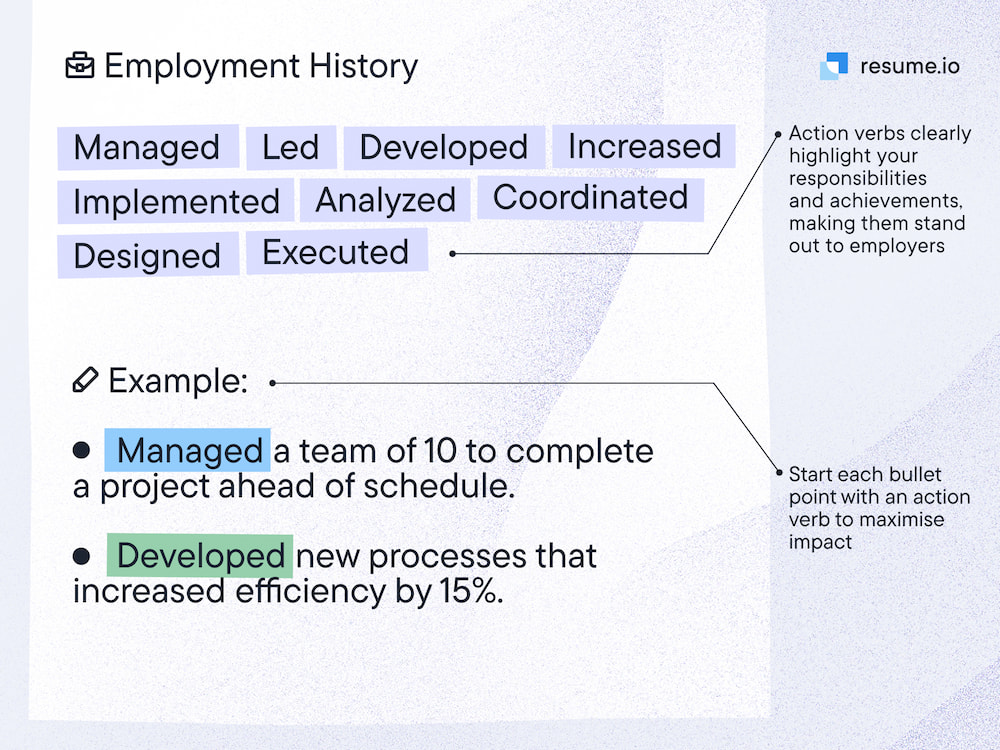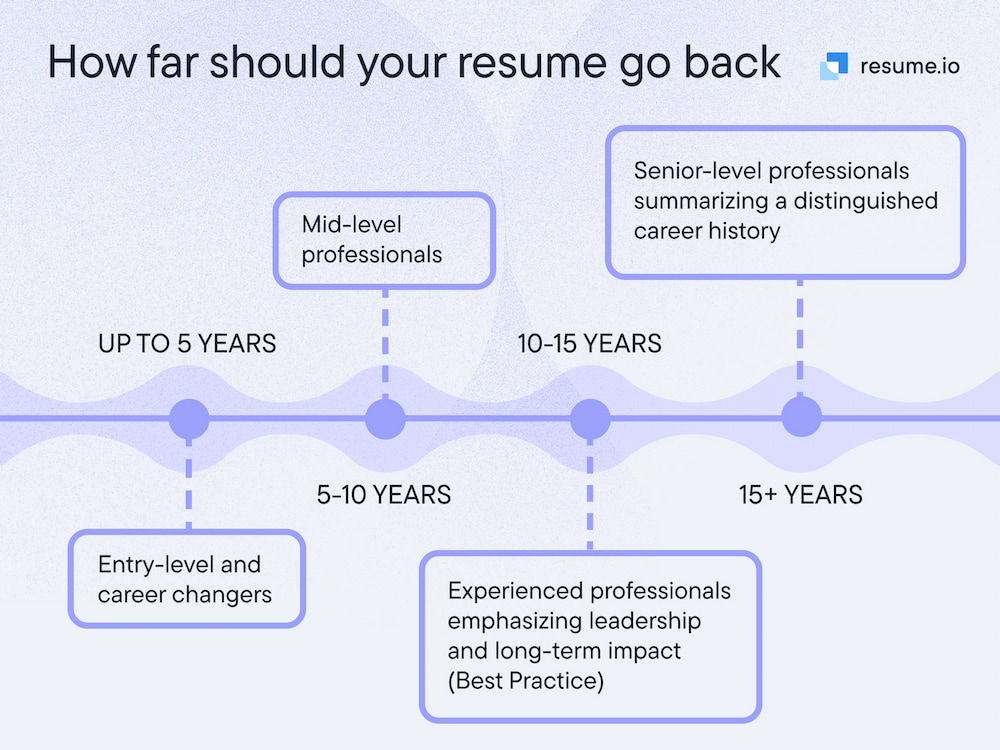Writing the work experience section
Writing the resume work experience section is one of the most influential and often trickiest resume sections to get right. Some employers will even cut right past the summary at the top of a resume and scan the employers, job titles and work dates to see if the resume is worth reading in detail. How much text you include for each section will also create a significant first impression. A lot can be understood during that mythical 6-second scan.
The work experience/job history on a resume is where past job descriptions and professional experiences give credibility to an application or interview. All the other information and sections on a resume, from hobbies to the personal statement, frame the list of relevant work experience over the last 10 - 15 years. So, how do I describe my work experience on a resume?
This guide will show you everything you need to know about including work experience on a resume, including:
- Why the work experience in cv matters
- What to include (and not include) in work experience on a resume
- The best format to follow for describing your work history
- Examples of work experience in cv across industries
- Practical tips for resume work experience
- How to list your current job and previous positions
The five-word rule. Think about five words that would be sum up your career. How would you describe your experience? Those five words should then come across incredibly strongly in the work experience on a resume. A hiring manager is not going to remember the sentences that you write, but if they stop reading with those five words (or more) in their minds, your resume will have done its job.

Why is work experience on your resume so important?
Before we jump in to the ins and outs of writing work experience on a resume, here is why it matters. A hiring manager or employer looks at a resume to answer one question:
Does this person’s work experience qualify them for this job?
The work experience section of your resume is the foundation that either qualifies you or disqualifies you for an interview or the next step in the hiring process. This resume section uses the last 10 - 15 years of relevant career history to tell a prospective employer whether you have the work experience in your cv that will fit the requirements of the role. The work experience section gives credibility to your application and should compliment every other aspect of your application materials (other sections in the resume, cover letter, portfolio, etc).
Be careful not to write your work experience section like a list of job responsibilities, though. The hiring manager knows what they want you to do. They are far more interested in evidence from your previous work experiences that you have what it takes to perform and take your next employer forward. Focus on offering compelling accomplishments, plenty of context and quantifiable results that your competition will not be able to match.
How do I add experience to my resume: What to include
In most cases, choosing which jobs to include on your resume should depend on your work history and the type of job you’re applying for. In general, work in a backward chronological order (in a resume format often known as reverse chronological format) starting with your most recent position at the top of the page and include the last 10-15 years of employment history. The backward chronological order works best for most job seekers.

If you have a scattered work history, don’t stress. Job hopping is both more common and more widely accepted today, especially among the younger workforce. Including short part-time stints and side projects is good if those professional experiences directly relate to the job or feature skills that overlap with the position. Be prepared to answer questions about your career choices while considering work experience in cv, have a confident answer about your career path, and be forthcoming about the level of commitment you’re looking for. Once you’ve chosen the positions, let’s dive into the specific bullet points about work experience in a cv. Each one should include:
- Results-focused facts: The hiring manager already knows the basics. These bullet points should focus on how you specifically managed the position with innovation.
- Action Verbs: Strong action verbs hook in the reader. Negotiated! Pioneered! Transformed! This also keeps you away from falling down the adjective rabbit hole.
- Quantitative information: Numbers stand out to a hiring manager. They are specific and tangible. You grew a client’s reader base by 300% or managed 200 silent auction items. Let your accomplishments shine!
- On-Site Training: Weave skills and certifications gained on the job. This shows initiative and otherwise overlooked abilities.
- Awards and honors: If you were called out on the job for great work, go ahead and brag. Your work experience resume examples should be designed to impress.

Ideally, each position should include a mix of free-flowing text and achievement-led bullet points. The bullets will catch the eye, but you can only really tell a deeper story when you are not constrained by the width of the page.
How do I write a student CV? A student CV for a first job should contain full details on your education (as that will testify to your ability to focus and achieve) and ideally also contain details on any student jobs or volunteer work that you have done while you were studying. It doesn't matter how menial this work was, the most important thing is that you understand the responsibility of doing a paid day's work.
Work experience on a resume: what to avoid
Always assume that your reader — in this case, the hiring manager — doesn’t need anything explained. You also have very little room to ramble on your resume. They will assume more about you than you think - especially if you have worked for a while in their industry.
Free up some space by not including:
- What the organization does: your resume is about you. The hiring manager doesn’t need to hear about the company.
- The basic requirements of your position: this is implied in your job title and will shine through your result-focused bullet points.
- Filler words: For the most part, save space by cutting out words like “I” and “the.”
- Anything irrelevant: If you have smaller responsibilities in a position that do not relate to the new job, leave them out. Every bullet point and every word takes up precious real estate on your resume - make them count.
- Chaired a project team through a change process, trimming 5% of our cost base.
- Outperformed sales team in quarterly new business attraction by 67%.
- Executed the software rollout to twelve departments within two months.
- Resolved a company-record 150 customer complaints a week.
- Rectified a list of outstanding issues that had been dormant for more than a year.
If you are a recent graduate with little or no work experience, you can consider adding your GPA or cum laude on your resume. As you acquire work experience over the years, you should replace your GPA or cum laude with relevant work experience.
What is the most effective format for work experience on a resume?
On a basic level, the work experience layout typically includes:
- Job title, company name, location of employment
- Month and year started and left the position
- Between three and six bullet points briefly outlining your impact at the company
Work experience/job history on a resume should also include:
- Clear and concise bullet points that demonstrate the positive results of your work
- Powerful verbs
- Clear numbers and facts
- Growth between positions
- Specific keywords pulled from job description
Examples of work experience on a resume
Here are a few examples of work experience on a resume to see the differences between a first draft and the final draft. How do you describe your experience in the most succinct way possible?
Example #1: Work Experience in CV for a Teacher. Let’s say you’re applying to be a middle school science teacher at a popular independent school. The new job description emphasizes the importance of involvement outside the classroom. They specified that they’re looking for teachers looking to grow through professional development throughout their time there.
First Draft:
- I taught 5th-grade science classes
- I advised students outside of class
- I attended a conference on social-emotional learning
Final Draft:
- Developed and carried out a student-driven curriculum in three sections of Earth Science
- Annually advised 20 students to track growth and address individual challenges and strengths
- Invited to attend NAIS annual conference to develop modern social-emotional learning classroom tactics
Example #2: Work Experience in CV for Content Marketing Manager. Content Marketing Managers encompass a very wide range of responsibilities. The recruiter will have a general sense of your job experience — no need to start from scratch — but results-based, specific bullet points will thrive here.
First Draft:
- I manage a team of freelance copywriters at a major NYC marketing agency and ensure they got their work in on time
- I talked to clients and figured out what would be best for their brand
- Before everything was published, I proofread it all
Final Draft:
- Oversaw a team of 25 freelance writers and streamlined content pipeline from ideation to publication
- Advised clients on both short- and long-term content strategy tactics while clarifying their personalized brand voice
- Edited and polished copy to maintain content consistency across multiple channels
Example #3: Work Experience on a Resume for a Waiter. Food service moves quickly. Anything that cut a manager’s search time in half is more likely to land you the job. Be sure to look for keywords in the job posting such as “craft cocktail bartending experience” or “fine dining.” Sure, you can learn — and will learn — on the job, but restaurants have minimal time to train you on the basics. Be confident and clear about your background.
First Draft:
- I waited tables at a busy NYC Midtown restaurant
- Most of the time, I tended bar on nights and weekends
- Trained a few hosts
Final Draft:
- Served lunch and dinner for four years in a Michelin-star-rated Midtown brasserie
- Acted as primary bartender during peak weekend and evening hours, specializing in craft cocktail creation
- Managed and streamlined training methods for new hosts and servers
Example #4: Work Experience Resume Example for an Executive Assistant. Personality plays such a large role in calmly managing a busy executive’s schedule and lifestyle. The tone of your resume should be both level-headed and confident in what is expected of an EA. Try to always be a step ahead of what your boss needs before you even begin the job.
First Draft:
- I made travel plans on behalf of executive team
- Budgeted for the office and managed expenses
- I trained other assistants and helped with hiring
Final Draft:
- Managed complex domestic and international travel for five, C-level executives
- Decreased expense management costs by 35% and perfected expense tracking system for all office management accounts
- Hired, trained, and guided a team of five team assistants including a seasonal team of sales interns
Example #5: Work Experience Resume Sample for Sales Rep. Provable facts and figures are your largest asset as a sales representative. Did your last position measure your personal or team sales growth? Dig up these numbers to work them into your work experience section. Then, explain the methods you applied in the job itself to make it happen. This work experience resume example offers some ideas:
First Draft:
- Grew sales revenue every month
- I signed several new clients
- I changed the way we talked about our product
Final Draft:
- Exponentially increased monthly sales revenue, surpassing 150% growth for the department after just 6 months
- Developed and signed 10 new key clients by researching previously undiscovered corners of our industry
- Redeveloped brand voice and sale representative script for efficient and personalized customer care
What skills do I put on a resume? when you are considering the work experience in a resume, you should aim to make the best possible use of space. There will always be a separate skills section where you can list one-word hard and soft skills, so make sure that this is related to the experience that you have mentioned with each employer, but it should add to the overall picture rather than simple repeat it. If you add an interesting skill that you have not mentioned in the work experience section, an employer is bound to ask about it at interview.

Grammar tips for listing job history on a resume
Do you write sentences? Phrases? Declarations? Writing resumes for first job? Here are some nitty-gritty grammar rules for writing your work experience bullet points.
- Write in phrases, often beginning with a strong verb. No need to write “I” to start off the sentence — that is implied and work experience in a CV is often conveyed in the third person as this is more professional.
- Tense: If you are still at your current position completing the work described, use present tense. For past positions or completed projects, choose past tense.
- Don’t be afraid to break out the thesaurus — especially for synonyms of “lead, managed and trained” — but stick to words you’d use yourself. No need to ace the SAT verbal section.
Tailoring job history on a resume for each application
Instead of mass applying to every job ad on the internet with the same resume, take the time to tailor it. The work experience section might require the least tailoring (as it will tick the boxes of most jobs if you are targeted in your approach), but there may be a few accomplishments that you may want to include for certain roles and exclude for others. View yourself as a meticulous editor cutting and pasting your career story to make it as attractive as possible.
Besides the fact that 36% of hiring managers throw out resumes that don’t seem personalized for a particular role, a tailored resume and application:
- Shows the hiring manager you took the time to apply and their job wasn’t one of 50 different places you sent your resume.
- Get past the automatic keyword filtering larger companies might use to automatically screen candidates in their Applicant Tracking System (ATS). Your work experience samples need to be scanned by the machines first.
- Tweak diverse experiences to focus on the most relevant experience for a particular job. For example if you’ve ever had a job “wearing many hats” unless you’re applying for another “many hats” position, this strategy gives you a chance to focus your work experience on the hats that are most relevant for the new role.
Restarting this process every time you apply for a new job may seem excessive. Ideally, the more time you put into tailoring your resume, the less jobs you’ll need to apply to.
- Ignited a fire under the management team to deliver an extra $950k sales.
- Scrutinized the market and doubled market share by launching a new product.
- Implemented a new software solution that shrunk build time by 34%
- Initiated a recruitment drive that hired fifteen people within three months.
- Minimized surgery wait times by 15 mins, increasing patient satisfaction by 25%
How far back should your resume work experience go?

Your resume work experience should contain every piece of information that is relevant to you securing the role. This will dictate the amount of work experience in a CV that you might include.
If you have a 30-year career, you might choose simply to list the employers for the first 10-15 years and use your precious resume space to describe the most recent resume experiences. However, if your career is 15 years or less, you should definitely include resume work experience about everything.
In terms of the amount of work experience on your resume, try to give more information on the more recent roles. Make use of bullet points and solid text after your have listed the employer and date details - as you can see in our many resume samples.
Including a list of roles that were more than 15 years old might be possible, but only include the headlines. It is interesting for some business leaders to see where a senior manager spent their early career, so while you may not be asked about this much during an interview, it does add a certain depth to your application.
Should I put seminars on my CV? Typically, a one or two-day seminar would not be included on work experience in a CV. If the training or educational event has a certain prestige or lasts more than a week, then you might consider including it in the education section, but as anyone can attend a seminar, it will not give a huge indication as to your individual level of suitability for the role. You will certainly have more important information to share.
Key takeaways
- Focus on results of your job history in the past. Only list work experience on a resume that is relevant to the job you’re applying to.
- Stand out with strong action verbs
- Get specific: use numbers, facts, and figures
- Speak in the past tense when the job is complete, present when you’re still doing the work.
- Cut out unnecessary filler words or adjectives.
- Align your job history bullet points to match the job description.
- Make sure that the work experience in CV goes back an appropriate amount of time
Work experience on a great resume helps employers know in 10 seconds or less if you are qualified for the job. It should sound a lot like the description in the job post. If the work experience in CV doesn’t sound like the job description or follow these rules, be prepared to pull out some creativity to get noticed. For example, use a resume builder to build a perfect resume in the exact format potential employers are looking for.









